Selected Reviews by Subject:- Film, TV, DVDs, CDs, media critics | Jews (Frauds, Freemasons, Religions, Rules, Wars) | Race | Revisionism | Women
Reviews of Authors: H Belloc | P Bustion | C Caskie | N Chomsky | R Dawkins | M Gardner | D Irving | K MacDonald | M Mathis | J McCabe | B Russell | H G Wells
| Chris Caskie is a young history graduate from New Zealand. Chris’ methodology is to combine standard history with facts about Jewish power across a broad range of subjects. Chris critiques how Jews act as a power bloc at the expense of non-Jews. Chris authored The War Against ‘Goyim’ (2022) which he has just updated (Nov 2023). His website (for now) is: https://chriscaskie.podia.com/ |  |
Chris Caskie's page
Books, Videos, Audios, Papers, Reviews from New Zealand
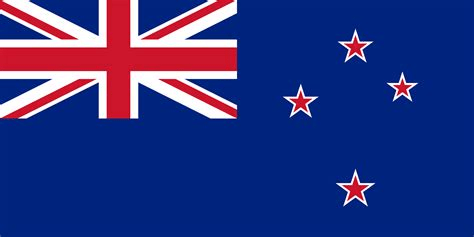

Email: chriscaskie@protonmail.com
This version v. 28 August 2024
Reviews are below, in this same page. PDF files are stored and can be downloaded individually. Audios and videos open in new tabs, and then play.
Most recent first:–
![]() Chris Caskie: Review of K S Lal's book The Legacy of Muslim Rule in India 1992. (Pdf file here).
Chris Caskie: Review of K S Lal's book The Legacy of Muslim Rule in India 1992. (Pdf file here).
Chris Caskie on War in Sudan: 28 July 2024 So-called civil war has hallmarks of being jew-funded
Chris Caskie: Review of 2 DVD 'Documentaries' of the Second World War 8 Feb 2024. (Pdf file here).
Chris Caskie: Review of Jüri Lina's book The Concealed History of Freemasonry 2024. (Pdf file here).
'Theory and Practice of Judaism' wide-ranging talk with Raeto West & Chris Caskie. January 2024. About 70 minutes.
Chris Caskie: Review of Benjamin Shapiro's book How to Destroy America in 3 Easy Steps 2024. (Pdf file here).
Chris Caskie: Review of Kevin MacDonald's book The Culture of Critique 2023. (Pdf file here).
Chris Caskie: Review of Robert Conquest's book Kolyma: The Arctic Death Camps 2023. (Pdf file here.
Chris Caskie: Review of Robert Conquest's book Harvest of Sorrow on the Great Famine 2023. Pdf file here.
Chris Caskie's video: Jews Organized the Second World War May, 2023. 39 minutes. Plus useful notes in the background.
Starts with a menu of times within the video, so material can be relocated and checked. Screenshots below:—
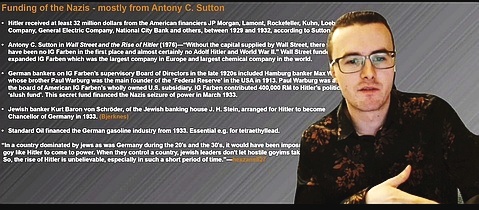 |
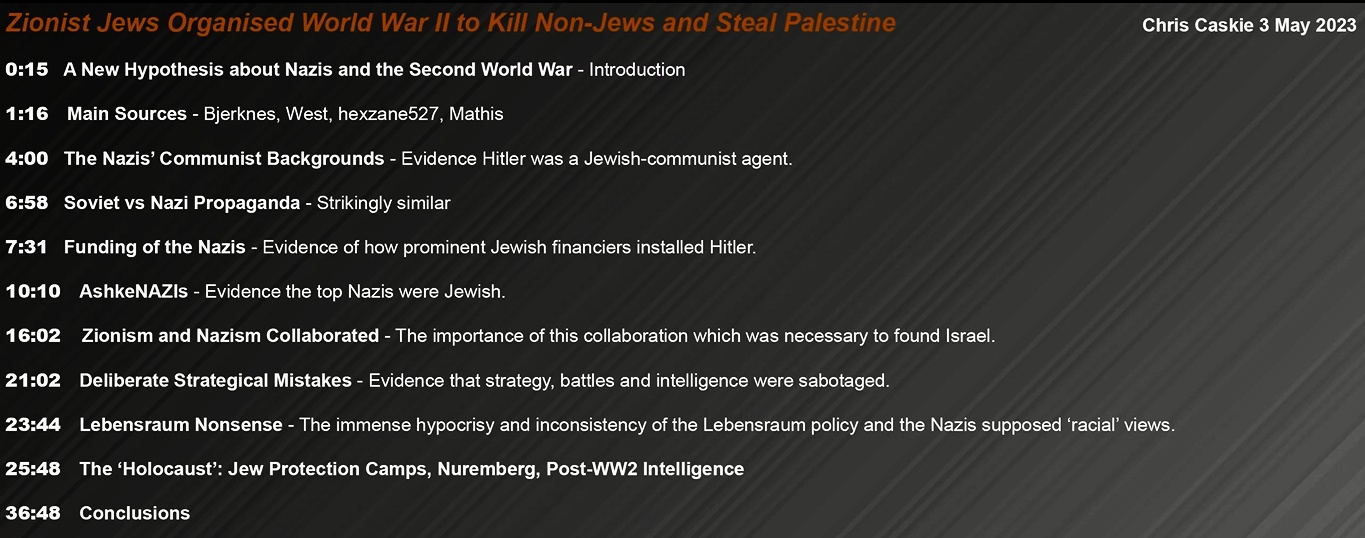 |
Chris Caskie: Review of Gehlen's Memoirs 2023, 15 May
Video dated February, 2023. Three-way talk mainly with C J Bjerknes (Illinois) and Chris Caskie (New Zealand). Chris B promotes his new book on Armenia and genocide; Chris Caskie recognises other genocides and is concerned with the whole system of Jewish 'philosophies' if they can be called that—many of the beliefs are absurdly wrong. 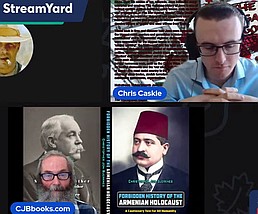 |
Chris Caskie audio. With Rae West. Audio discussion. 2022, 3 May
My review of Chris Caskie's The War Against Goyim Review dated Feb 2022
‘The Legacy of Muslim Rule in India’ by K S Lal
Review by Chris Caskie
The Legacy of Muslim Rule in India
by K.S. Lal
Review by Chris Caskie
Centuries of Violent, Unethical, Backward
Muslim Rule, largely Unknown in the West
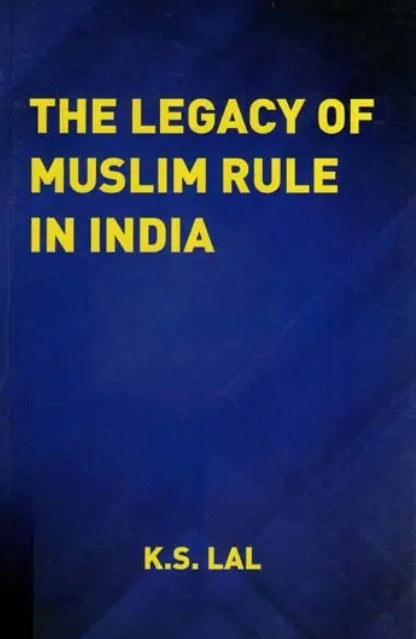
Contents (plus subdivisions for each chapter
and endnotes at the end of each chapter)
1. Preface
2. Abbreviations used in references.
3. The Medieval Age
4. Historiography of Medieval India
5. Muslims Invade India
6. Muslim Rule in India
7. Upper Classes and Luxurious Life
8. Middle Classes and Protest Movements
9. Lower Classes and Unmitigated Exploitation
10. The Legacy of Muslim Rule in India
11. Bibliography
Preface: The page numbers I cite refer to a PDF version. They may be different to your version, but can be trusted to be approximate.
![]() 4 Stars
4 Stars
Kishori Saran Lal (1920–2002) was an Indian historian who estimated that Muslims
killed approximately 60–80 million Hindus in India between 1000–1525, which he
argued in his book Growth of Muslim Population in Medieval India (first published in
1973). To date, Lal’s estimates have not been debunked, only challenged without
any counter-assessment. Lal’s work was drawn to my attention by
hindugenocide.com, a website that collects various sources and tries to raise
awareness about the odious legacy of Islam in India. In this review, I aim to highlight
what I thought were the main points, and consider the shortcomings.
Lal’s work now seems very underrated, under reviewed, and now mostly forgotten, out-competed by mountains of erroneous, repetitive Jewish rubbish. Books like popular ‘non-fiction’ mass market paperbacks, which incredibly include no citations at all. Lal’s book is well-written, with a solid bibliography consisting of original sources (including official documents from the Islamic regime), foreign travelers’ accounts and modern works. Lal pointed out the controversy of discussing the foul deeds of Islam in India. Even the Board of Secondary Education explicitly stated not to mention the destruction caused by Muslim invaders. (p. 278)
Lal starts the book by situating the societal structures that underpinned the Middle Ages, and compares and contrasts Europe and India during this period, which were both under an Abrahamic yoke. Lal points out that Islam enforced “a rigid, narrow and limited scriptural education could, parrot-like, repeat only one political theory—Man was nasty, brutish and short and must be kept suppressed.”(p. 7) In other words, Islam—similar to Christianity—has a cynical outlook on humanity, partly based on the idea that people are ‘sinners’. ‘Sin’ is a nonsensical concept, popularised by Jews, used to threaten and unduly blame people. The cynical outlook of Islam (and Christianity) are in contrast to Judaism, which extols and motivates its followers, emphasising that Jews are wonderful and entitled.
Lal mentioned the importance of the divine right of kings during the medieval period, which also applied under Islam—“Obedience to the ruler was advocated as a religious duty.”(p. 8) Thinking broadly about the medieval period, the doctrine of the divine right of kings was useful in promoting and solidifying the power of puppet royals.
Muslim Invasions and Principles of War
Lal dates the first invasion to 712, when Muhammad bin Qasim invaded Sindh (today Sindh is a southern province of Pakistan). It took five hundred years for its establishment (712–1206) and one hundred and fifty years for its decline and fall (1707–1857). (p. 278) According to Lal, initially Muslims had a simplistic approach: If people didn’t want to convert, they were simply forced to, and if they didn’t, they were killed. (p. 15) Unlike Christianity, Islam offered polygamy, license of concubinage and frenzied bigotry, which Lal thought appealed to people. Nowadays, many Muslims believe (or pretend to) because they don’t have much choice, or they are too ignorant to foolish to understand it’s rubbish. To this day, the emphasis on the family in Islam is effective in keeping people adherent. If people want to abandon Islam, they may be disowned or severely criticised by their family, something not viable for young people to do, and by the time they’re older, they’ve accepted it for so long it’s difficult to abandon it.
Lal cites the Quran as a source of inspiration—“The one supreme duty the Quran. taught them was to fight the infidels with all their strength, convert them to Islam and spread the faith by destroying their idols and shrines. In Surah (Chapter) 2, ayat (injunction) 193, the Quran says, Fight against them (the mushriks) until idolatry is no more, and Allahs religion reigns supreme. The command is repeated in Surah 8, ayat 39. In Surah 69, ayats 3037 it is ordained: Lay hold of him and bind him. Burn him in the fire of hell. And again: When you meet the unbelievers in the battlefield strike off their heads and, when you have laid them low, bind your captives firmly (47.14-15). Cast terror into the hearts of the infidels. Strike off their heads, maim them in every limb (8:12).”(p. 78) Note the command to destroy ‘idols’ is taken from Judaism and was also practised by Christians in Europe. Jews invented Christianity to takeover Europe and used it to destroy European paganism, which Jews regarded as ‘idolatry’.
Lal explained Jihad—“The main medium through which these injunctions were to be carried out was the holy Jihad. The Jihad or holy war is a multi-dimensional concept. It means fighting for the sake of Allah, for the cause of Islam, for converting people to the true faith and for destroying their temples. Iconoclasm and razing other peoples temples is central to Islam; it derives its justification from the Quranic revelations and the Prophets Sunnah or practice. Muhammad had himself destroyed temples in Arabia and so set an example for his followers. In return the mujahid (or fighter of Jihad) is promised handsome reward in this world as well as in the world to come. Without Jihad there is no Islam. Jihad is a religious duty of every Muslim. It inspired Muslim invaders and rulers to do deeds of valour, of horror and of terror. Their chroniclers wrote about the achievements of the heroes of Islam with zeal and glee, often in the very language they had learnt from their scriptures.”(p. 77)
According to Lal—“The Muslim regime in India depended for sustenance and strength not on the Indian people but on foreign Muslim Caliphs and potentates.”(p. 117) The Muslim regime also received a great deal of foreign military support, particularly from Turk or Afghan soldiers. They were an important source of strength for the army. (p. 127) Another strength of the army was its slave system. Young Hindu boys were captured as slaves and indoctrinated into Islam and made soldiers. (p. 129) Often times (Lal discusses a case under Shah Jahan, reigned 1628–1658), a massacre was ordered of the male population above eight years old, and the remaining women and children were enslaved. (p. 243)
A staggering number of soldiers were involved in the occupying Muslim army. For instance, Alauddin Khalji (1296–1316) commanded 475,000 horsemen, and Muhammad Tughlaqs cavalry is said to have consisted of 900,000 soldiers, though, of course, the numbers wavered. (p. 131) War elephants were also used, though their efficacy is debated. “Many of the strongest fortresses in India have elephant spikes upon their doors to hinder such form of assault.”(p. 131) For many of the soldiers, loot was their sole source of income. (p. 132) In peace times, soldiers often still looted or destroyed civilian property, extorted and murdered people, as if they had nothing better to do. (p. 134)
Life in India under Islam
Lal wrote—“Non-Muslims suffered even more because of censorial regulations. Tradition divided them into seven kinds of offenders like unbelievers,infidels, hypocrites, polytheists etc. who are destined to go to seven kinds of hell from the mild Jahannum to the hottest region of hell called Hawiyah, a bottomless pit of scorching fire. A strict watch was kept on their thought and expression. They were to dress differently from the Muslims, they could not worship their gods in public and they could not claim that their religion was as good as Islam.”(p. 21) According to Islam, humanity is divided into believers and ‘Kafirs’, and Muslims ought not to cooperate on the basis of equality with ‘Kafirs’. Throughout their centuries of control, the Muslims made no attempt to build a state with a broad system that benefitted various sections of the population.
Muslim law decrees mutilation as a punishment, often for minimal offences. For example, Alauddin Khalji ordered that if any shopkeeper sold any article short of weight, a quantity of flesh equal to the deficiency in weight was to be cut off from his haunches. (p. 265)
Lal quoted Beni Prasad who stated that when the Islamic regime in India became more tolerant, it was only out of necessity to maintain their rule—“By the fifteenth century the age of systematic persecution was past but the policy of toleration was the outcome of sheer necessity; it was the sine qua non of the very existence of the government.”(p. 139)
Anti-Intellectual and Derivative Attitude in Islam
No universities were established or maintained by Muslims in medieval India. They only destroyed the existing Hindu ones, which also attracted foreign students. The Muslims didn’t even set up Muslim institutions of higher learning. Education in Islamic India remained private and anyhow was mostly restricted to Islamic rubbish. Writers, scholars, teachers, and artists generally remained under the direct employment of kings and nobles. Consequently, little emerged from that period that could be called popular literature, folk-literature, etc. (p. 29)
Unsurprisingly, throughout medieval India, there was little scientific development or learning. Lal wrote how even candles and torches were a luxury—“Right up to the time of Babur there were no candles, no torches, not a candle-stick. Even in the 75 Mughal palace, utmost economy was practised in the use of oil for lighting purposes. The common man lived in utter darkness after nightfall.”(p. 27) 76
Lal cited History of Aryan Rule in India, by E.B. Havell (London, 1918) in which Havell maintained that Islamic architecture e.g. mosques were copied from Hindu architecture, and by extension, Islamic literature and art. (p. 29) There’s a likely school of thought that the Taj Mahal was actually built by Hindus.
Class in India
The nobility of the Islamic state in India was diverse, largely originating from various foreign families. For example, Persians, Turks, Uzbeks, or indigenous converted Rajputs. The advantage of having an ethnically diverse bureaucracy is that the administrators could play one group against another, e.g. Sunnis could deal with Shias, etc. (p. 136) The nobles were called Umara and were graded as Khans, Maliks, Amirs and Sipehsalars in the Sultanate period, and as Mansabdars under the Mughals. According to the author of Masalik-ul-Absar, a Khan commanded more or less 100,000 troops, an Amir 10,000, a Malik a thousand, and so on. (p. 155) Miles Mathis in his paper Tartar demonstrated that Genghis Khan was Jewish (Khan being derived from Cohen, and many contemporaneous writers described him as Caucasian; not Asian). Mathis’ findings raise the question of how much of Khan’s posterity, followers and subordinates were Jewish and/or had ties to Jews or other secret societies. Given the foreign support for Islam in India, Jewish fingerprints are expected.
Government mismanagement and corruption was standard fare, with administrators squandering money on personal things rather than using the money for government projects. (p. 161) Many higher class Muslims were hypocritical, keeping harems despite adultery being prohibited in Islam, and drinking wine, despite alcohol being prohibited.
The majority of the Indian popular was (as described by Lal) lower class, mostly being artisans in urban centres, and peasants in rural areas. Lal refers to accounts from Jahangir’s reign in the early 1600s, which describe many peasants as having no furniture and the poorest of them being naked. (p. 229) According to Lal—The principle of the Shariah was to leave with him [the peasantry] only as much as would have helped him carry on with his cultivation, but at the same time to keep him poor and subservient. (p. 230) Beginning during Alauddin Khalji’s reign (1296–1316), the Muslims aimed to break the resistance of the peasantry. They normally hated Islam, and weren’t as venal as urban-based people who could get more of a leg up by converting. The Islamic state began imposing exorbitant land tax (called Kharaj) e.g. 50%, plus house-tax and grazing tax. (p. 231) If the peasants didn’t pay, they became slaves. If they fled (which happened often) or died, it was a common practice to demand the arrears from their neighbours. (p. 237) According to Lal, the widely enforced bare subsistence policy, “left no incentive for increasing the production or improving the methods of cultivation.” The impoverishment and oppression of the peasantry in India under Islam reminds me of the USSR, where the peasants’ resistance was also broken, in that case through famine. Both Jews and Muslims favour urban, service-based economies and de-emphasise the primary sector. Both ideologies are parasitic. Their strengths are in bureaucracies and emphasis on propaganda and ideologies to try to win people over through force, or long-term inculcation. The Abrahamic approach is never to impress with raw intelligence, ideas or solutions. Suppression of opponents is necessary.
In my opinion, Lal made a common mistake. I think the main weakness of his methodology is his rigid division of groups of society into upper, middle and lower classes. Lal even uses the bogus term ‘bourgeoisie’, which is often conflated with upper class, but in fact Marx & Co. meant middle class. That 1800s wave of fake Jewish ‘socialists’ never attacked the rich industrialists who owned the companies. Marxism was controlled opposition (see Miles Mathis). The crude Jewish-promoted 3-level class structure ignores many probable gradations in class. Don’t be duped by the idea that there has to be just 3 classes. Obviously e.g. poor Hindus and poor Muslims shouldn’t technically be in the same class.
I felt this book could’ve been longer, but then again, Lal wrote other books dealing with Islam in India.
Addendum
'Civil War' in Sudan
Revisionist Analysis by Chris Caskie
chriscaskie@protonmail.com wrote:
Hello Rae,
Yes, the current so-called civil war in Sudan has many hallmarks of being funded by Jews. I’d wager a lot that it is. I did some cursory digging, which revealed many red flags, so to speak.
Long story short, there are two main sides. One side, the Rapid Support Forces, control gold mines and are exporting gold to Russia and the UAE. In turn, Russia and the UAE (supported by the US) are supplying them with weapons, missiles, etc, and training. In particular, the Wagner Group in Russia, a private company run by a Prigozhin, a scion of a Jew oligarch family. Israel sold them equipment, too. I doubt they’re manufacturing any of their weapons, a lot of their gear is probably newish. As for the other side, the Sudanese Armed Forces, representing the old government, they are also being funded by Russia. So, it appears we have a classic Jewish scheme in play, with both sides being funded and the Jews not involved hedging their bets as they go.
This war in Sudan is much bigger in scale than Gaza, and is related to the war in Yemen, since there’s mutual support with some of the factions. I suspect Gaza is being emphasised in a monomaniacal way to divert attention away from it.
I haven’t seen any other revisionist perspectives on Sudan, but looks like Jew business as usual. We shouldn’t be surprised.
Chris
Some Second World War DVDs
Reviewed by Chris Caskie
World War II in Colour and Apocalypse: World War II
TV Mini Series’ (both 2009) Dual Review
by Chris Caskie
2 stars - Similar narratives, exemplifying the conventional Jewish framing of World War II. Both are devoid of solid evidence, presenting only unreferenced information. Minimal value for showing how Jewish ‘conventional wisdom’ concerning World War II is presented.
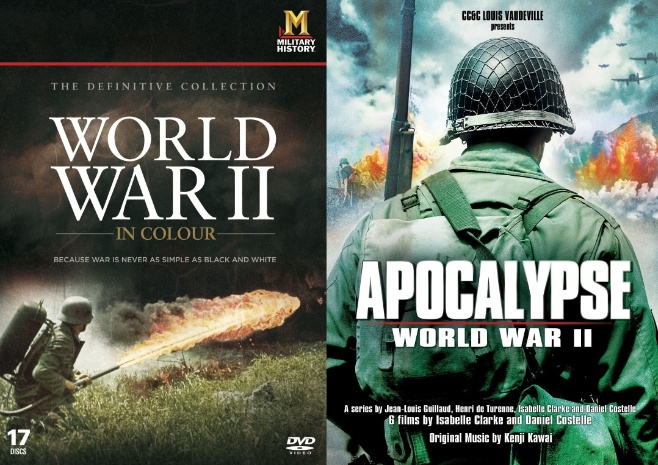
I watched a few episodes of these series’ online (not all of them) to remind myself of the conventional Jewish view of WW2 to contrast it with updated revisionist discoveries. The narrators basically just explain different battles, which often transpired in a seesaw manner, with no clear supposed winners until the end, as was probably intended by the Jews controlling both the ‘Axis’ and the ‘Allies’. All the juicy information is brushed under the rug. Unsurprisingly, absolutely nothing on funding, and I didn’t see anything on trade/aid, either. And hardly anything on intelligence. Hitler intervening and/or disagreeing with advisors at the expense of Germany is a constant theme. No analysis attempted to explain all the puzzling decisions, which, by now, are beginning to be decoded. Hitler is framed as an independent actor, hiding the now-probable fact he was just another cog in a well-oiled Jewish machine.
Both narrators speak in a lucid English voice, interwoven with orchestral soundtracks, intent on sounding authoritative. Many of the sound effects were no doubt added, since I doubt all the camera people had microphones handy! Another typical Jewish feature is the inclusion of useless, trivial details. One of many examples, in Apocalypse WW2, it’s mentioned that all 8 of Magda Goebbels’ children were given names starting with H, in reverence to Hitler. Who cares? They won’t tell you anything helpful, like that fact the Nazis were given millions of dollars by Jewish bankers in America so they could ‘win’ the German election, or the fact many of the top Nazis were Jews and/or freemasons, or the fact the Nazis helped Jewish emigrants to move to Israel and the ‘Holocaust’ (which these documentaries, of course, rigidly conform to) was made up to insulate Israel from criticism, etc.
People are so used to thinking programmes like these are documentaries, but they are NOT authentic documentaries because they do not document their claims. They are more like fictional stories, in keeping with the Jewish tradition of myths and fantasies. They rely on action and explosions, like Hollywood movies, grandiose soundtracks for emotional effect, and carefully selected voice actors—all a façade to mask logical truths. The narrators very rarely cite a researcher, a book, a document, or an eyewitness account. After watching a few episodes, the only sources I heard explicitly mentioned were A Woman in Berlin, mentioned in Apocalypse WW2, concerning mass rapes of Germans by the Red Army, which the script in fact understated, and Mein Kampf. Of course, part of the appeal of these series’ is they feature colourised footage. However, none of the footage is credited! Who filmed it? Who was being filmed (when not obvious)? When was it filmed? etc. No captions are provided. To be fair, not all details may be known, but some effort would be better than none. Such is the state of WW2 historiography: endless mediocre, shallow researchers repeating the same old trite rubbish over and over again, relying on tenth-hand sources and missing the big picture that the devastation was likely staged by Jews.
CC
Architects of Deception: The Concealed History of Freemasonry by Yüri Lina
Review by Chris Caskie
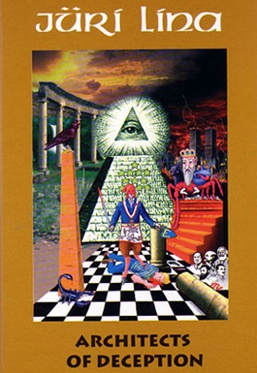
From ordinary architects to architects of deception: An overview of the Corrupt Deeds and Methods of Freemasons throughout history
24 January 2024
A very good Jew-aware case study of freemasonry. Long (500+ pages).
Architects of Deception: The Concealed History of Freemasonry by Estonian Jüri Lina (originally published in 2004 by Referent Publishing in Sweden) details the origins, practices, impacts and criminal legacy of freemasonry. It traces freemasonry as the common denominator in many important events where the truth has been suppressed. These include the world wars and many 'revolutions', and biased financial and propaganda controls. Lina exposes how freemasons networked, used nepotism, deceit and financial power to control puppets and take over societies.
My motivation for reviewing this book is two-fold: Firstly, I was a big fan of Lina's previous book, Under the Sign of the Scorpion: The Rise and Fall of the Soviet Empire, which preceded this book by a few years. Secondly, I was deficient in knowledge of freemasonry and its impacts. Lina's book has convinced me that freemasons were more numerous and important than I'd thought. If we consider the intellectual landscape of revisionism, freemasonry is underrated in modern discussions. Years ago, it was a more vogue topic. I think this shift in focus is due to freemasonry being far less popular nowadays than in the past: Lina cites statistics of their membership declining. An important adjacent question how freemasons have interacted with other corrupt and secretive groups, particularly Jews, whose record of unprovoked callousness is very disturbing, something Lina doesn't ignore.
First of all, I appreciate the cover design of Architects of Deception. It's artistic, featuring various freemasonic symbols, including the hideous spider creature Jahbulon (the supposed god of the freemasons). Many non-fiction books have very basic covers, which are arguably a bit boring and uninteresting compared to the likes of this cover. In terms of the formatting, Lina includes subtitles in his table on contents, which is helpful. Herein I will highlight some important parts of the book, but there's so much I think this book ought to be studied in detail.
Freemasonic Infiltration and Influence
Scotland was an early locus of freemasonry, since the Knight's Templar founded a lodge there in 1420, after being banned elsewhere. The templars were Jews and important controllers of the crusades against Muslims pursuant of the Zionist cause of capturing Jerusalem. At any rate, the templars infiltrated guilds and made them freemasonic. Initially, masonry might not have appealed much to people, but once people saw the practical benefits of joining it, it attracted venal types. The archaic symbolism, rituals, etc were more or less residual, but no doubt still believed by some, similar to how modern Christians often downplay the spiritual aspects.
Lina pointed out—"Freemasonry spread more effectively in Christian countries due to its parallels." (p. 551) In America, the Jehovah's Witnesses, Mormons, and Christian Science church groups were all founded by freemasons.
Lina on national bans on freemasonry—"Under certain circumstances, it is the highest and holiest civil duty of the freemason to raise arms against the legal government of a nation, according to The Freemason Chronicle (London, 1875, I, p. 81). For this reason freemasonry had already been banned in several parts of Europe: in Naples 1731, in Poland 1734, in Holland and France 1735. Catherine the Great banned the activities of secret societies on 8 April 1782 and again in 1794 in order to prevent the continued activities of the lodges in Russia. The freemasons had simply refused to obey her. The lodge Osiris simply continued with their actions against Russia. Ordinary people regarded freemasons as treacherous criminals." (p. 289)
Lina on the 'French Revolution'—"When I first entered the headquarters of the Grand Orient in Paris in September in 1999, I was confronted with a large red triangle with slogans along its three sides: Liberte, Egalite, Fraternite (freedom, equality, brotherhood). This shows that the Grand Orient was behind the so-called French Revolution. The freemasons do not deny this, instead they claim in their periodical Humanisme (No. 240, June 1998) that this orgy of violence was indeed their work. The republic was declared by the freemason Jean Marie Roland on 21 September 1792. The versifier of the "Marseillaise" [French national anthem since 1792] was the freemason Claude Roget de lisle (Humanisme, No. 235, September 1997, p. 24)." (p. 282)
Moreover—"Eighteen of Napoleons marshals were freemasons, including Bernadotte, Brune, Jourdan, Kellermann, Massena, Mortier, Murat, Ney, Oudinot, Poniatowski, and Serurier (the French periodical Historia, No. 48, July-August 1997). (p. 295)
Lina is expert on the USSR. Virtually all the high-ranking commissars were freemasons, in addition to being Jews, e.g. Lenin, Trotsky, Kamenev, Sverdlov, Zinoviev. (p. 116)
Austria is an interesting case study of a freemasonic stranglehold—"There was a time when nobody could be a member of the Austrian government without being a freemason. (p. 243) Lina lists leaders in finance and media in Austria who were freemasons." (p. 244)
Lina on freemasonry in Hollywood—"B'nai B'rith founded in the early 1920s a lodge also in Hollywood, with Alfred Schwalberg, Baranay Bapaban (Paramount), Harry Goldberg (Warner Brothers) and other leading figures within the American film industry. The lodge received the number 1366. Between the years 1925 and 1935, "the king of movies" Willy Hayes gave B'nai B'rith's president Alfred M. Cohen the option to scrutinise all scripts that had anything to do with Jews." (p. 219)
Of the 41 presidents of the United States 14 were freemasons, or roughly 30 per cent. In 1929, the year of the stock market crash, about 67 per cent of all members of Congress belonged to the freemasonry. (Paul. A. Fisher, "Behind the Lodge Door", Rockford, Illinois, 1994, p. 246). (p. 221)
Freemasons have a range of oaths and rituals, including keeping the secrets of the order under threat of being killed in a horrible ritual—"Freemasons who are accepted into the lodge must swear the bloodcurdling oath, in which the novice promises never to discuss any of the aims or activities of the order with outsiders. Neither is he allowed to visit other lodges without permission. In addition to this, he accepts that his throat will be cut, his heart removed, his tongue and entrails torn out and thrown into the sea, his body burned and the ashes spread in the wind, so that nothing of his substance remain among men and master masons, if he tells anyone what he has learned about the plans of the freemasons. "I confirm this, my oath, honestly and truthfully, so help me God to life and soul." (Sverre Dag Mogstad, "Frimureri — mysterier, fellesskap, personlighetsdannelse" / "Freemasonry — Mysteries, Brotherhood, Personal Development", Oslo, 1994, p. 281).
Freemasons Led by and Subservient to Jews
• British Prime Minister Benjamin Disraeli spoke in 1852 to the House of Commons, referring to the events of 1848: "The natural equality of men and the abolition of property are proclaimed by the secret societies, which form the provisional governments; and men of the Jewish race are at the head of each of them." (p. 81)
• The rabbi Isaac Wise (1819-1900), chairman of B'nai B'rith's suborganization in Cincinnati, Ohio, explained that "freemasonry is a Jewish establishment, whose history, grades, official appointments, passwords, and explanations are Jewish from beginning to end." (Israelite of America, 3 August 1866).
• The following could be read in the French masonic magazine Le Symbolisme (July 1928): "The most important duty of freemasonry must be to glorify the Jews, which has preserved the unchanged divine standard of wisdom."
To quote Lina on page 80—"Freemasonry became a Jewish-Cabbalist conspiracy, the aim of which was to subjugate the civilised Jewry and to enslave the rest of humanity. In 1869, a Jew was grand master of the Scottish Rite in Paris (Henry W. Coil, "Coil's Masonic Encyclopaedia", Macoy Publishing, Richmond, Virginia, 1996, p. 260). The Grand Orient admitted Jews without restrictions. Morin's mission was to make all gentile freemasons function as extremist Jews or as their henchmen. In any case, they serve in the interest of Zionism."
Lina's Chapter How the Freemasons Helped Hitler to Power
Lina traces the ideology of 'national socialism' back to Moses Hess, who coined the term and geared it towards Jewish nationalist purposes. (p. 398) Hess also advised Marx and pioneered Zionism. (p. 398)
An important book Lina discusses is De Geldbronnen van het Nationaal-Socialisme (The Financers of National Socialism) by Sidney Warburg, published in 1933, which is in the social archive of Zurich. In June 1929, bankers and industrialists met secretly in New York and agreed that French economic progress should be halted and that a 'revolution' should happen in Germany, and they decided on a 'National Socialist' regime. (p. 356) This was suitable since 'communism' failed to get a foothold in Germany in the 20s.
Lina, (pp. 363-364) on identifying the financiers—"The agreement between Hitler and the bankers in June 1929 was signed among others by John D. Rockefeller, Jr, J. H. Carter (Guaranty Trust Company, The National City Bank of New York), the banker Tommy Walker, and President of the United States Herbert Clark Hoover (1929-1933), most of them high-ranking freemasons. The press mogul William Randolph Hearst (Consolidated Publications) was also present at this meeting. This important information former economics professor Antony Sutton gives in his book "Wall Street and the Rise of Hitler" (Sudbury, England, 1976). The information was verified and made more specific by the German politician and author G. Schmalbrock."
"In total, Hitler received at least 32 million dollars from the American financiers (Morgan, Lamont, Rockefeller, Kuhn, Loeb & Company, General Electric Company, National City Bank and others) between 1929 and 1932 (Antony Sutton, op. cit., p. 134)." (p. 371) In 2024, that's equivalent to about $672,000,000 US, or about £527,000,000, which could be spent on e.g. propaganda.
Hitler himself was apparently a freemason. Lina's evidence (which I haven't verified, but will check later) includes Franz Bardon's book Frabato the Magician (1979); Norman MacKenzie's book Secret Societies (1967) and Rudolf von Sebottendorf's book The Magicians (1933), which the Nazis banned. Additionally, Lina discusses Hitler's supposedly non-coincidental freemasonic gestures, for example, the essential sign: arms crossed on the chest (the sign of the grandmaster, the symbol of power).
Lina also discussed how the German economy under Hitler was directed by the freemasonic director of the national bank, Hjalmar Schacht. Many Hitler advocates marvel at the recovery of the German economy under the Nazis. The economic recovery obviously helped the Nazis gain the trust of the German population. However, at the same time, the Nazis arguably wasted vast amounts of money and manufacturing capabilities to prepare for a war pursuant of Jewish interests.
Lina is good on how high-ranking freemasons in America funded both the USSR and Germany before and during World War II. For example—"Throughout the war, Rockefeller's oil tankers supplied fuel for Hitler's submarines, enabling them to successfully sink American ships. The submarines were refuelling usually in the immediate vicinity of the Canary Islands (Charles Higham, "Trading with the Enemy", New York, 1984, p. 61). The Jewish historian Ladislas Farago, at the time working for the American intelligence, agreed: "Hitler's submarine war against British-American shipping during the winter 1942-1943 was a success thanks to the help he received from Rockefeller." ("The Silent War", Stockholm, 1956, p. 77). (pp. 449-450)
Nazism created a climate in Europe that scared Jews into emigrating, often to Israel, since other countries refused to accept Jews. On the back-end of World War II, the phony 'Holocaust' helped the state of Israel gain sympathy to exist, despite their arrogation of land—"The Nazis wanted to do everything to accommodate the Zionists demand for as many Jews as possible to settle in Palestine. In 1933, the Hitler administration and the Zionist Central Organization signed an agreement for the Jewish emigration to Palestine. There were so many new settlers that many Arabs suspected Hitler of being Jewish and a crypto-Zionist. In 1934 alone, 120 000 German Jews emigrated to Palestine. Until September 1940, 500 000 Jews from Germany and from occupied Poland had emigrated to Palestine. In 1950, it was claimed from official Jewish sources that the total amount of Jews in Palestine from various European countries only amounted to 80 000. As many as 420 000 of those present were listed as gassed in the camps. Even though they were alive and well in Israel, the Zionists considered them victims of the holocaust and demanded retribution for them (Weckert, "Feuerzeichen: Die Reichskristallnacht" / "The Kristallnacht: A Beacon", Tubingen, 1981)." (pp. 399-400) However, at the same time, only a chosen few Germans were allowed to travel abroad, even in the 30s before wartime. (p. 384)
Harry Truman, President, freemason and grand master of the Grand Lodge of Missouri (1940-41) was reported in the New York Times on 24 June 1941 as stating—"If we see that Germany is winning, we ought to help Russia, and if Russia is winning, we ought to help Germany. And that way let them kill as many as possible." (p. 448) What a nasty prick. This statement implies the maximisation of goyim deaths thesis re WW2.
Flaws of this Book
• Some explanations of events in this book are out of date, but for 2004, Lina did well. For example, Lina gave credence to the mythology of nuclear neapons and the (likely fake) JFK assassination, which were convincingly revised a few years later.
• The introduction to the book did not rope me in. I found the book to be a bit of a slog at first until it really picked up. But it's worth pursuing for the good parts, in my view.
Conclusion
Lina hopes for the future. He thought 'karma' will have a retaliatory effect on freemasons and other evildoers. Lina presented no evidence for karma, and this line of thinking is, honestly, a cop-out. In the end, if you care to discover the truth about freemasons and their immense lies and crimes, this book is a great starting point, or reference point. However, expect loose ends and take some of Lina's claims with a pinch of salt.
How to Destroy America in 3 Easy Steps by Benjamin Shapiro
Review by Chris Caskie
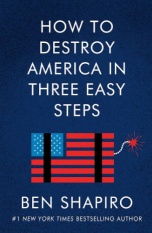
Rating: 1 star
Contents:
Introduction
Chapter 1: The American Philosophy
Chapter 2: Disintegrating American Philosophy
Chapter 3: The American Culture
Chapter 4: The Disintegrationist Culture
Chapter 5: The American History
Chapter 6: Disintegrating American History
Conclusion
Notes
Index
Ben Shapiro (I’ll call him Benny to be subtly disparaging) is a commentator in America who has received a considerable following, for example, on Youtube, amidst the chronic censorship of serious commentators. Benny identifies as a ‘modern Orthodox’ Jew. These Jews tone down some of the more archaic and embarrassing traditions, at least in the public sphere. However, they still accept many of the erroneous, absurd and supremacist fundamentals, which include unfair double standards when dealing with non-Jews. How to Destroy America in 3 Easy Steps (2020) is one of Benny’s most popular books. My motivation for reviewing it is noticing his apparent popularity and disliking his arguments and personality, like many others. So I thought I’ tackle one of his recent books from the vantage point of being Jew-aware and see how wrong it really is.
Immediately, we have 3 red flags: Published by HarperCollins, promoted on Amazon, and endorsed by the Jew York Times. HarperCollins is a hyper-conventional publishing titan. Amazon has a record of censoring books that rock the Jewish boat. At the time of writing, this book has accumulated several thousand 5-star reviews on Amazon, but perhaps some of the reviews are fake. His endorsement from the Jew York Times is brandished on the cover. According to Benny, the Jew York Times has a ‘liberal’ bias. So why is endorsing him if he claims ‘iberals’ are censoring him? In reality, it’s just one of many promotional propaganda institutions, promoting endless mediocre Jew after Jew. It’s been run by Jews since its inception, the most famous owners being the Sulzbergers. At this point, almost any non-fiction book endorsed by the Jew York Times will be inaccurate, or just plain rubbish. Let’s find out...
The cover art struck me as a bit tasteless. The colours are a nod to Benny’s promotion of blind patriotism: red, white and blue. The font is very safe. The central image looks like something lazily done in Microsoft paint or something. The formatting isn’t bad, but could have been better. The contents have subsections, but they are not denoted in the contents. The book includes many hyperlinked citations, an awful lot of famous people: US Presidents, ‘founding fathers’, ‘enlightenment’ thinkers, with some Internet articles mixed in. Here’s a sampler: Martin Luther King, Thomas Jefferson, George Washington, Alexander Hamilton, Plato, Aristotle, Adam Smith, John Locke, Thomas Paine, Abraham Lincoln, James Madison, Karl Marx, Barack Obama, Woodrow Wilson, Franklin D. Roosevelt, Lyndon B. Johnson, etc—a rogues’ gallery of Jewish frauds, whom Benny is echoing. How to Destroy America probably has too many citations, as if Benny was unfocused, which I think this book shows.
My copy is a free online PDF, without page numbers (the actual book isn’t worth 10 cents). Pretty much from the beginning, Benny pushes the left versus right paradigm in a divisive manner. Benny doesn’t point out the now well-known reality that the left versus right paradigm is part of a divide and rule strategy, implemented with worrying success by rich Jews and freemasons, notably in America. Benny must understand that much corruption is mutual on both main political sides, but yet he advocates for the republican side. Both the democrats and republicans have long been controlled by Jews, with administrations full of Jews, and heavily funded by Jews. For example, Biden and Trump’s administrations employed more than 50% known Jews. Moreover, most/all presidents have probably been Jews (this can be deduced from various things, including their relations to ‘British’ royalty, documented e.g. by Burke’s Peerage), and about a third freemasons (according to Paul A. Fisher in Behind the Lodge Door, 1994). Revisionist breakthroughs of this caliber are absent from Shapiro’s recycled tribal scribblings.
Benny’s 3 steps to destroy America are:
1.“Convincing citizens that some people will have to sacrifice their existing
rights in order for others to have new ones.”
2.“Undermining our culture of rights in favor of a culture of protection by
government.”
3.“Convincing citizens that America represents fruit of the poisonous tree: that
America was founded in evil, and that there is no arc to history.”
Benny has (or pretends to have) nostalgia for the ideas American society championed in the past, which he argues are disintegrating. Through his boring meanderings, he, of course, omits the truth about Jewish control of the African slavetrade in America and hence the related economics (refer to work by e.g. The Nation of Islam). Why would Benny omit this fact? Many Jews in positions like Benny are insecure about truth and have a vested interest in bogus narratives. In any event, Benny would rather opine about philosophical humdrum. Benny’s comments on the American Civil War, Lincoln, etc, are, of course, unrevisionary. Benny discusses American ideals, including standing up for freedom. All the people Benny quotes are well-known people, showing that Benny hasn’t researched deeply. He just parrots generic American mantras, being intellectually bankrupt.
In discussing ethical values, Benny laughably cites Genesis from the Bible, stating that humans were created in “God’s image”. Benny, naturally, omits the kaleidoscope of evil material in the Bible, supporting mass murder, enslavement, rape, torture, human sacrifice, and so on. There are in fact commandments in Benny’s religion to kill non-Jews, because they are non-Jews. For example, commandment 598: Wipe out the descendants of Amalek—Deuteronomy 25:19. Jews have followed these. Case in point, Jews mass murdered 1.5 million Armenians in the 1910s whom they identified as ‘Amalekites’ (mythical enemies of Jews). You’re more likely to win a million dollar lottery than find Benny being honest about such issues.
Benny likes strawman arguments. For example, Benny claims critics of America say things like “American culture was racist and cruel” and “American history was a litany of abuses.” But these statements are caricatures. Do people seriously make these facile arguments? Maybe casually. It’s not that simple of a question. Benny constantly encourages thinking in black and white terms, like his old hat left versus right game. He wants you to believe something like all ‘iberals’ say X and they are categorically wrong, without attention to nuance, fixating on simple, boneheaded binaries. Benny also doesn’t distinguish between liberals who have good intentions and belligerent phonies, like much of Antifa.
Benny discusses ‘disintegrationists’, i.e. people who think that the USA should be divided into smaller countries. Benny does not mention any plans activists have proposed to ‘balkanise&lrsquo; the USA, which would make for potentially prescient material. For example, the movements for Californian independence and North-Western independence. Benny does not consider people of different political persuasions who are interested in America splitting into different factions. Different nationalist groups agree and disagree on different aspects of balkanisation. Benny missed a golden opportunity to discuss all this.
Benny apparently thinks America is the “greatest country in the history of the world.” Well, maybe for Jews. America is, in reality, far less flash than Ben makes it out to be. America is 30+ trillion in debt; has a large knowledge economy with a stupefying output of media rubbish; many Americans work excessive hours; healthcare is notoriously exorbitant; illegal immigration is out of control; the US has been at war for most of its years of existence, at the expense of taxpayers; the US has a poor quality education system, including Bible-in-schools rubbish; the US’ supposed freedom of speech is a myth, since many people are unemployed for having certain views; the US has very geographically disparate concentrations of power, with the northeast and California, for example, having far more power than other regions. On the whole, America is arguably too big of a country to manage and in practice is more like an empire. Benny doesn’t come close to offering solutions for any of these issues, being mired in passe ideas and values. Benny is a typically impractical Jewish thinker, relying on vague values and acting as if beliefs will take care of everything. Some religious Jews think America represents ‘Edom’, the successor of the Roman Empire, and they ought to be destroyed. After all Americans have done for Jews, Jews are happy to jettison them. Benny is much the same—he doesn’t really care. He’s just found a niche where he can make money and have some semblance of intellect.
Benny sells, at this time, 15 other books, such as one on how television is controlled by the ‘left’. You have to laugh. The evidence of Jewish control is monumental. Benny lies to his audience and rips them off with bullshit. Well then, what use is this book? This book is a rock-solid example of Jewish propaganda, evading truth and masquerading as revelatory. It’s a drop in an ocean of propaganda sewage, disseminated and praised courtesy of Jewish ownership and promotion. I hope people learn to discern trash books like this one in future.
CC 11 Jan 2024
The Culture of Critique by Kevin MacDonald.
Review by Chris Caskie
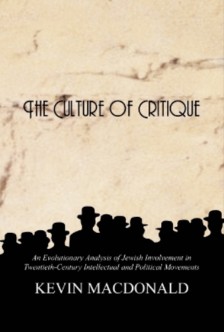
29 December 2023
Rating: 3.5/5 Stars - might seem a bit low given this book is widely lauded amongst students of Jewish power, but thinking about the scope of Jewish power and asking what a book should do to educate people, I’m happy with that rating.
Summary: A cutting edge analysis of Jewish anti-white ideas and actions and in this respect, the book deserves acclamation. However, this book tells a very incomplete story and is a typical specimen of academic narrowness. Plus, in my view, the formatting could have been better.
I think the best chapters in The Culture of Critique are the ones on the Frankfurt School and the one on Jews shaping US Immigration policies. The thing that stuck with me the most that MacDonald documented was the staggering hypocrisy of Jews who, for instance, promoted values such as equality or multiculturalism, such as the movement of Boasian anthropology, or the Frankfurt school. However, these movements hypocritically resembled Judaism in that it they had a strong in-group preference, double standards and were intolerant of dissent. Moreover, Jewish exponents never pointed out how their own population were overrepresented in positions of power and how, by their own definitions, this constituted supremacy or privilege.
The Culture of Critique frames Jewish influence as a corrosive Left Wing force but does not discuss the Right Wing, or any other political ‘wings’ which were also Jew controlled, and also did enormous damage e.g. Jew-controlled right-wingers in the USA promoting foreign wars. MacDonald discusses how and why Jews supported anti-white ideas and immigration reforms but does not discuss the black side: how blacks were ripped off with ‘civil rights’ and stabbed in the back by Jews who feigned sympathy for them. MacDonald doesn’t really draw any satisfying juicy conclusions from evolutionary psychology. Are Jews more likely to be psychopaths, for example?
As someone concerned with accurate history, the book is void of anything informative on massive twentieth century wars, genocides, famines, disasters, etc: massive human and material destruction that Jews orchestrated. Arguably, these topics are not MacDonald’s expertise. But that’s exactly the problem: academics tend to pigeonhole themselves into singular fields. No wonder many people aren’t enthralled by academics and why they can’t relate to them. At least this is a general observation I’ve made.
Something not unique to MacDonald’s book that blights many non-fiction books is the lack of subtitles in the table of contents. Looking at MacDonald’s contents, the chapters are without subtitles. For example, chapter 3 starts at page 50, and chapter 4 starts at page 105. We’re left with 55 pages in between with no signposting, making quick referencing difficult. The preface to the second edition is 74 pages—far too long. My book, The War Against ‘Goyim’, by contrast, has a one page introduction, bearing in mind many people want to get to the point.
Another subtle problem is the title. Is Judaism really a ‘culture of critique’? In my view, it’s more of a fanatical culture of secret supremacy and malice. I think revisionists need to attack Jewish supremacy more aggressively, without losing focus, if that makes sense. MacDonald, and I may as well include his contingent over at the Occidental Observer, are not, and probably never will be, heavyweights in the fight against Jewish power. MacDonald plans to release a third edition. Don’t expect much.
CC 29 December 2023
Kolyma: The Arctic Death Camps by Robert Conquest.
Review by Chris Caskie
A Study of the (Jewish-run) Death Camp Network in Kolyma, Russia
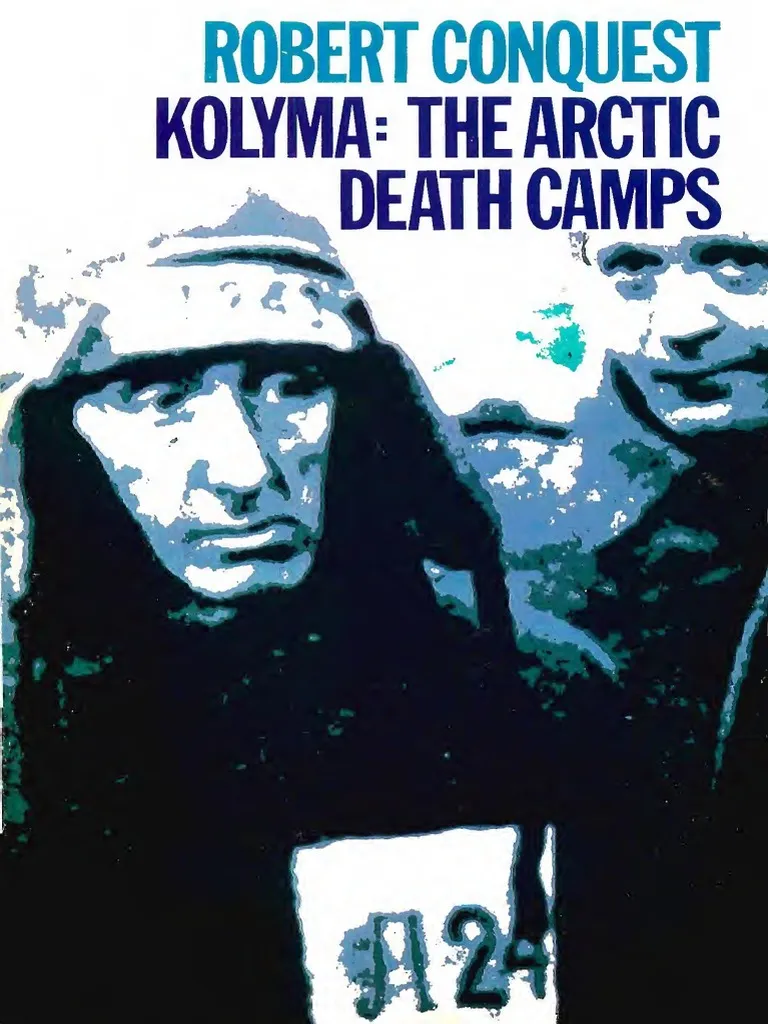
Contents
Introduction
The Middle Passage
Into Kolyma
1938—Baptism of Horror
The Social Order of Kolyma
Gold Under Ice: the Kolyma Economy
Living and Dying Conditions
Women
A Clownish Interlude
The Death Roll
![]() The book could’ve been longer (it’s 231 pages) and it loses points for ignoring Jews.
The book could’ve been longer (it’s 231 pages) and it loses points for ignoring Jews.
Kolyma: The Arctic Death Camps by Robert Conquest (originally published in London by Macmillan in 1978; my version published by Oxford University Press in 1979) seems to be the best account of the Kolyma death camp network in Siberia. Conquest’s sources were former ex-prisoners; other Soviet writers; reports published in the West or the Soviet press, and new unpublished information. Conquest’s prose is good and clear. However, this book is a gloomy read. In this review, I will highlight what I thought were the best parts and the shortcomings.
The USSR (so-called ‘Union of Soviet Socialist Republics’: 1917–1991) is infamous for its vast network of Gulags (Gulag is an acronym that stands for “Chief Administration of Corrective Labour Camps”). A mendacious title since the camps were veritable death camps that nursed criminality and offered no educational work. Many people are vaguely aware of what happened, but aren’t conversant with any details. To this day, university courses, publishers, and writers still understate the horrors of Gulags. In my opinion, the reason for the censorship is a Jewish fifth column in publishing and media who have a vested interest in narratives that are whitewashes of history, designed to prop up Jews, neglecting far more genuine victims. It is no wonder this book is now out of print.
Already in 1921—some 4 years after the Jewish takeover—the Jews had built the Kholmogory death camp in the arctic, where prisoners were routinely killed and replaced. Mikhail Kedrov (Jew), head of the military section of the Cheka, was an important administrator. The 1930s marked an increase in the institution of Gulags. People were sent to these camps for the most trifling offences. The prisoners included farmers, intellectuals, writers, artists, dissidents, and criminals. In the Gulags, prisoners were killed for any dissent whatsoever. If they refused to work or said aloud that the work was harsh; disagreed with a guard; criticised the government; or kept quiet while the crowd of prisoners yelled “long live Stalin!”, they were shot.(p. 53)
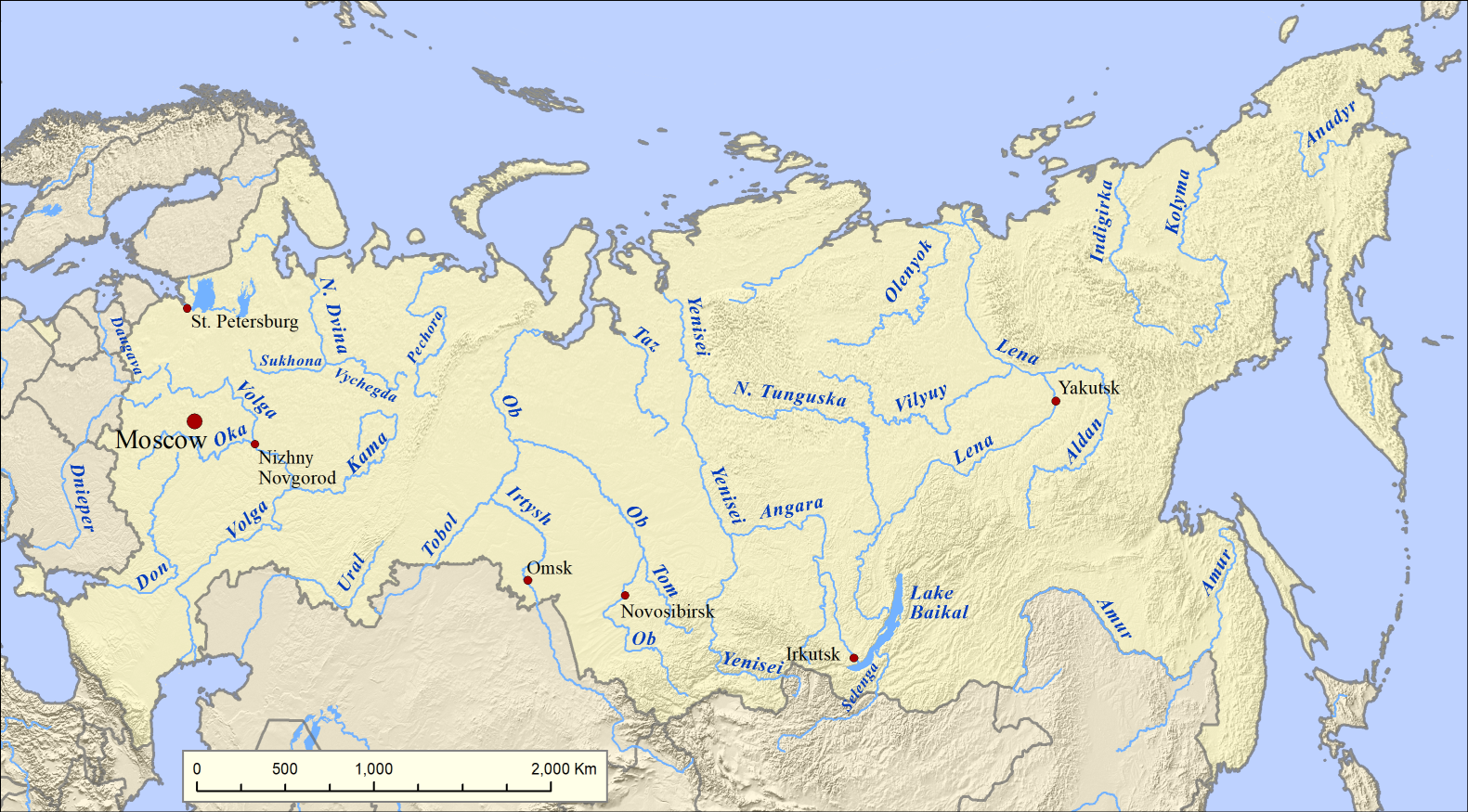
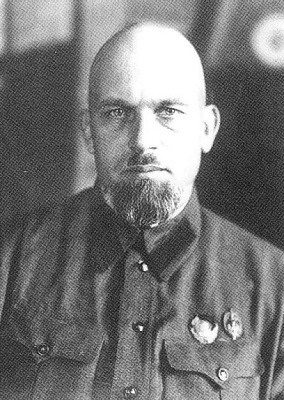
Conquest captured the bone-chilling atmosphere and
conditions of Kolyma, which were atrocious and often
unsurvivable. The official work day was 10 hours,
however it was raised to 12 hours in 1941 due to the war, and less officially it was
often 16. No holidays were permitted. (p. 63) Most work was unpaid, and any
allowances were very meagre. In winter time, prisoners were forced to work in
-65°C of frost. (p. 136) They were provided with totally inadequate clothing and
accommodation. An ex-prisoner recounted—“Prisoners were not dressed for the
climate in the kolyma region. They were given third-hand clothing, mere rags, and
often had only cloth wrapping on their feet. Their torn jackets did not protect them
from the bitter frost, and people froze in droves.”(p. 134) Some camps had
barracks; others only had makeshift tents. Conquest quoted a prisoner who
described the camp at Shturmovoy—“The tents were full of gaping holes through
which blew the cold winter air. The broken iron stoves were not lit. The filth was
unbelievable. The beds had neither mattresses, blankets, nor pillows. Only here and
there dirty rags lay strewn about.”(p. 58) Rationing was very strict. Sometimes,
prisoners were given ‘soup’ consisting of water with a small amount of
flour. (p. 131) Hygiene conditions were horrendous and prisoners were afflicted with
lice and typhus epidemics. A typhus epidemic in 1938 claimed tens of thousands of
lives. (p. 22) Prisoners were rarely allowed to bathe. In some camps they bathed
every six months. (p. 136) In 1938, the administrators imposed the Katorga
system where prisoners worked in special camps, in chains, and without
blankets or mattresses at nights. None survived. (p. 60) Conquest told stories of
prisoners who would purposely get ill or creatively self-mutilate to try to escape their
misery. (p. 141) Conquest quoted a camp doctor called Major Vostokov, who told a
prisoner—“Before being a doctor, I am a chekist, and as such I must tell you that
you are not brought here to live but to suffer and die. If you live . . . it means that you
are guilty of one of two things: either you worked less than was assigned you or you
ate more than your proper due.”(p. 64) Conquest accounted no heroic escape
stories since escape was virtually impossible, especially without suitable clothing,
food, or directions.
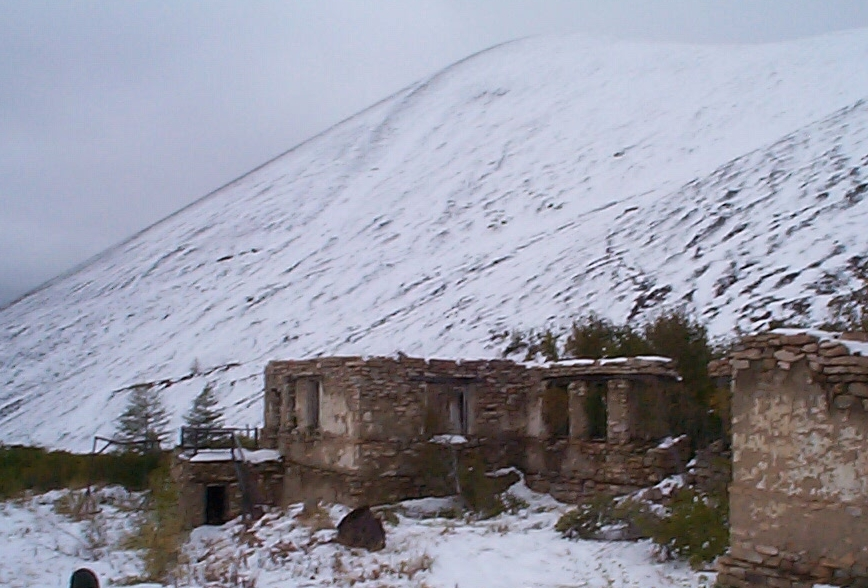 Butugychag Tin Mine — part of a Gulag camp in the Kolyma region—now in ruins.
Butugychag Tin Mine — part of a Gulag camp in the Kolyma region—now in ruins.
| 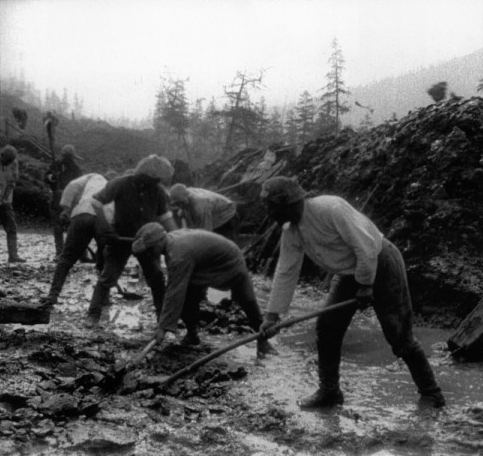 Construction of the bridge through
Jakutsk).
Construction of the bridge through
Jakutsk).
|
Conquest estimated 5–6 percent of people imprisoned at Kolyma were women. (p. 176) Conquest noted that—“Rape was, of course, regularly practised by urkas [criminal prisoners]. A twenty-one-year-old girl about to become a school teacher, but arrested for being of Polish descent and given ten years, was on cleaning duty at the Magadan men’s camps. One day, the guard to take her back to the women’s camp had not arrived when a brigade of men returned from work. They were, as it happened, urkas, and invited her into their barrack where twenty of them raped her. She caught both syphilis and gonorrhea. A prisoner who worked with her comments, “Her experience was not unique in Kolyma.” (p. 182)
As with all of Conquest’s books, he did not account for the significance of Jews, or their interests. For instance, according to the Jewish researcher and publicist Arkady Vaksberg in Lubyanka (Stockholm, 1993), eleven out of twelve chiefs of camps in the Gulag were Jews. The most infamous of them were Naftali Frenkel and Matvei Berman (who are credited as the inventors of the Gulag system), Aaron Soltz, Yakov Rappaport, and Lazar Kogan. Obviously, it wouldn’t make sense for Russians to be so cruel to each other. In my view, the Jews in Russia had an animus against Russians, which is reflected, for example, in Jewish literature about pre-‘Soviet’ Russia. Conquest, subservient to mainstream discourse, mentioned Auschwitz-Birkenau as a similar death camp system. Conquest was totally blind to the cornucopia of amenities at Auschwitz, now laughed at by revisionists as a “horror Disneyland”. Conquest was disgraced by the lack of publicisation of the mass killings in the West, but he did not understand that the censorship was Jewish.
Another shortcoming of this book is that Conquest did not account for the raw materials, particularly gold, that were extracted at Kolyma. Conquest cited an estimate that every ton of Kolyma gold cost about a thousand human lives. (p. 110) The Jews in Russia had an appalling record of economic theft and mismanagement. For example, the historian Igor Bunich in his book The Party’s Gold (1994) mentioned that (the Jew) Lenin had collected 400 million roubles in gold from Kiev, 500 million from Odessa and 100 million from Kharkov, but he felt absolutely no inclination to give any of it away to the starving. He announced—“We have no money!” Jewish Chekist thugs also stole jewelry during house searches.
Conquest reflected on the Kolyma death camps and how they encompassed the ‘Soviet’ (i.e. Jewish) attitude towards ‘goyim’—“The vast death factory of the Kolyma camps is, in fact, to be attributed flatly and directly to the political system which created it. It was, by its sheer scale, by the petty murderousness of such regulations as the banning of felt boots, by its whole attitude and method, more than a mere negative attribute of that system. On the contrary, it was that system, carried to its logical end. Kolyma—the threat and actuality of Kolyma—was the way the Soviet government imposed itself on its subjects.”(pp. 230–231) Conquest estimated that the Kolyma death camp system cost 3 million lives—a conservative estimate.(p. 227)
Chris Caskie - 30 July 2023
The Harvest of Sorrow by Robert Conquest. (First published 1986)
Review by Chris Caskie
Evidence that Famine in Ukraine, Russia and Kazakhstan in the 1930s was a Genocide and Understanding the Jewish Motive of Eliminating ‘Goyim’
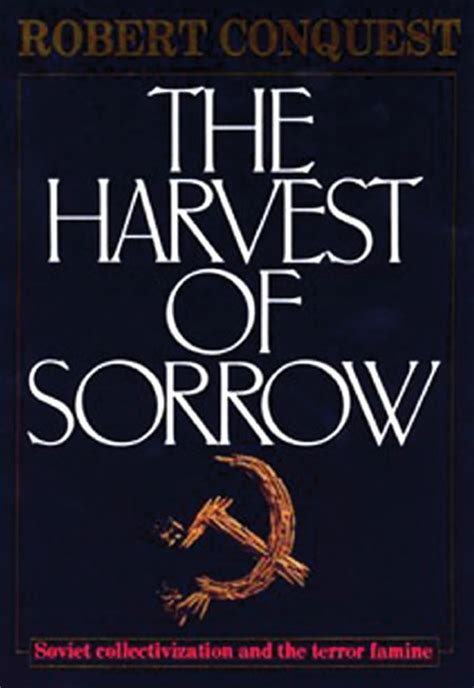
One of many cover designs. Many show the hammer and sickle, representing workers and peasants. The 'intellectuals', Jews, are always omitted.
Conquest dissected two policies, implemented in the late 1920s, which facilitated the Holodomor, namely ‘collectivisation’ and ‘dekulakisation’. ‘Collectivisation’ involved the abolition of private property in land, and the concentration of the remaining peasantry in ‘collective farms’ under state control. ‘Collectivisation’ was implemented alongside ‘dekulakisation’, which involved the killing or deportation of millions of peasants. Peasants had their houses and property confiscated and they were removed with their families in cattle trains. Those who didn’t die along the way were forced into slave labour camps, which ensured death for many. Supposedly, the state was concerned with rich peasants called ‘kulaks’, but this was a lie; peasants were targeted regardless of their social class, similar to the supposed targeting of the ‘bourgeoisie’, which was more or less a euphemism for any ‘goyim’ Jews felt like killing off. Conquest pointed out that—“Stalin’s policies were presented in terms of a class analysis which made little apparent sense. They were also economically destructive in that they led to the ’iquidation’ of the most efficient producers in the countryside.”(p. 119) Another part of the build-up, typical of Jewish-run atrocities, was propaganda scene-setting. The Jewish director Sergei Eisenstein, in state.sponsored propaganda films, depicted ‘kulaks’ as fat, lazy, oppressive monsters. (p. 134)
Conquest made a convincing case that the famine was a genocide. The Soviet government (mostly Jewish) set excessively high grain requisition targets, which they knew were excessive, yet they enforced the targets until starvation began, and they continued enforcing them throughout starvation. Convoys were sent to confiscate farm produce and any foodstuffs that were ready to eat. While rations were established in the cities, no allowances were made in the villages, of which entire villages were exterminated. Orders were given to prevent peasants from entering the towns and expel them when they did. Food that was stored in the famine-afflicted areas was never released to the starving. Orders were given and enforced, to prevent food from being brought into Ukraine. Anybody who was caught hiding foodstuffs was either murdered or sent to slave labour camps. (p. 329) The excessive grain targets were not imposed on the most productive grain-producing areas, such as the rich Russian Central Agricultural Zone. (p. 327) However, even poor Ukranian regions were targeted. All this evidence strongly suggests genocidal intent. Furthermore, the famine is fully established and corroborated by witnesses: the peasants themselves, local activists, Soviet officials and foreign observers. Nevertheless, it was made illegal within the USSR to suggest that there was a famine and Soviet spokesmen abroad were instructed to deny that famine existed. (p. 329)
Step by step, Conquest adduced evidence of genocide. Conquest concluded—“The only conceivable defence is that Stalin and his associates did not know about the famine. This appears impossible to maintain in the face of the above. The verdict must be that they knew that the decrees of 1932 would result in famine, that they knew in the course of the famine itself that this had indeed been the result, and that orders were issued to ensure that the famine was not alleviated, and to confine it to certain areas.”(p. 327) Conquest estimated 7 million Ukrainians died as a result of the famine (of which 3 million were children) and 14.5 million died in total as a result of collectivisation. At the time of writing, Wikipedia, citing only one source, claims 3.5–5 million died in the Holodomor, while, of course, erroneously maintaining 6 million Jews died in the holohoax. Watch out for this: Popular sources are likely to underestimate the Holodomor as more people learn about it.
It’s safe to say the biggest weakness of this book is Conquest’s blanket ignorance of Jews in the USSR regime. Jewish orchestrators included Stalin as premier (refer to Miles Mathis’ research for evidence of Jewishness); Lazar Kaganovich, as deputy premier; Yakov Yakovlev as People’s Commissar for Agriculture; Grigory Kaminsky, as head of Kolkhozsentr, the main farm agency for the Russian republic, overseeing the collective farms, and Filipp Goloshchyokin as Party Secretary of Kazakhstan. Jews also controlled the NKVD law enforcement agency, who enforced the famine. I recommend consulting Jüri Lina’s book Under the Sign of the Scorpion: The Rise and Fall of the Soviet Empire for lists of names of Jewish functionaries in the USSR.
In terms of motives, Conquest stated—“When it comes to motive, the special measures against the Ukraine and the Kuban were specifically linked with, and were contemporaneous with, a public campaign against their nationalism. In these, and the other areas affected, the apparent concern in the agrarian sphere proper was to break the spirit of the most recalcitrant regions of peasant resentment at collectivization. And when it comes to the Party itself the result, and presumable intention, was to eliminate those elements insufficiently disciplined in the suppression of bourgeois-humanitarian feelings.”(p. 329) Another motive, underrated by Conquest and other researchers, is that the produce seized through collectivisation was sold to make money. Historians cite figures such as 2 million tons of grain exported in 1929, but I haven’t seen people assess how much money was made.
In my opinion, one of motives of the famine was simply to kill off ‘goyim’, in accordance with Jewish ethics. Why Jews would want this? My working hypothesis is that Jews were historically a very religious group, wherever they were in the diaspora. Jews who did not agree with their group ethics, notably hostile attitudes towards outsiders, left their community. At the same time, their religion was the glue that held their community together. Therefore, over time, I suspect there was a selection process for Jews who became, on average, more mentally acclimated to thinking in ways that are consonant with their religious ethics. Jewish thinking habits, amply evidenced in Jewish-mediated affairs around the world, include routine lying, as encouraged by Jewish stories and laws; lacking empathy and remorse for others; not accepting blame for wrongdoing; being paranoid about others; feeling victimised and being fanatical about ideas. These are all negative traits; possibly some positive traits were selected for as well. This phenomenon, also observed in other populations, is normally referred to as ‘cultural selection’. In my view, cultural selection in Jews, consolidating genotypic expressions, explains why, for instance, Jews who are not religious still often behave in corrupt ways, and why hardly any Jews have spoken out against Jewish hegemony. I should point out that these traits may be subtle and may be absent in some Jews. I think it’s a case of a higher frequency of these traits among Jews and I don’t think these traits normally dominate the thinking of Jews, since many Jews may be perfectly normal or reasonable in other facets of their psychology.
Case in point, the starvation of millions of Ukrainians and others was completely unfair and unjustified, but the Jews who orchestrated it were not unreasonable in all of their thinking, neither were they psychopathic or anti-human in all aspects, unlike e.g. some serial killers. However, the fact is, large numbers of Jews acted in lockstep manner to starve, murder and imprison people on a wholesale scale. This sort of cruel aggression towards others seems to be proportionately far more common in Jews. There are many comparable examples, such as the Jews who influenced ‘communism’ and famine in China; the Jews who organised atrocities against Russians and Germans during the Second World War; the Jews who organised the genocide of the Armenians, Assyrians and Greeks in the 1910s–20s; Jews who mass murder and displace Palestinians while claiming to be victims; Jews arranging military incursions into Middle Eastern countries, backed by fear porn about terrorism; Jews encouraging violence against whites in South Africa, and so on. It’s been a long-term pattern of rich and powerful Jews to arrange mass deaths of perceived enemies. In sum, I think that Jewish antagonism against ‘goyim’ is rooted in their psychology, ossified in a process of selection according to their religious ethics. I don’t think Jews planned the selection process; I think it was an incidental consequence of their cultural evolution.
Chris Caskie - 23 July 2023
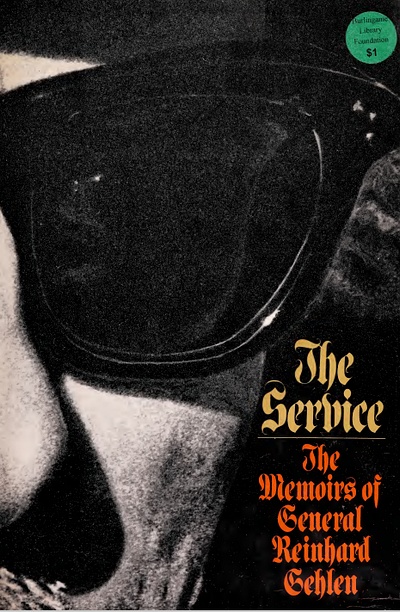
Translated from the German by David Irving. New York: The World Publishing Company, 1972. Translated by David Irving.
I was recently looking at the memoirs of Reinhard Gehlen, who was chief of the Wehrmacht Foreign Armies East military intelligence in WW2. [Downloaded from a site b-ok]. He reflects on supposed mistakes. He also discusses how ex-Nazis collaborated with American intelligence agencies like the CIA after WW2, to incite false flags, etc, in Europe to perpetuate the communist vs nazi divide and rule. It's called 'Operation Gladio'. It suggests international Jewish cooperation. This book is roughly in two parts. The first part looks at the Second World War from Gehlen’s vantage point as the head of German intelligence on the Eastern Front. I read this part with RW and Hexzane527’s hypothesis about WW2 in mind, which reconsiders German mistakes to be deliberate sabotages, rather than oversights. This will sound ridiculous prima facie, but it’s logical and in line with Jewish motivations and manoeuvres in every field, in every country, for millennia.
The second part of the book deals with post-1945 intelligence agencies and the ‘cold war’. Naturally, nuclear propaganda features strongly. I found a lot of this material to be outdated. This was Gehlen commentating and speculating about current events, rather than recalling his own experiences, and I don’t think he had much to say.
I have selected some excerpts from the book below, which illustrate the huge mistakes (or sabotages) made by the Third Reich:
Page 24: “Instead of weighing carefully each step he took, he [Hitler] began a dangerous poker game and shut his eyes to the fact that sooner or later he would be dealt a losing hand. Even in 1939 he did not deserve to win. Our forces were nowhere near ready for war, and if the Allies had shown resolution in their political and military actions when war broke out, there would have been at most a short period of armed conflict followed by the defeat of Germany, a defeat which seemed certain from the outset. ... even by the summer of 1939. ... Our stocks of heavy-artillery ammunition—including that of the heavy field howitzers—were virtually exhausted.”
In other words, if the USA had joined WW2 earlier, Germany would’ve easily been defeated. Hence, it wasn’t until late 1941 when the USA joined. Hexzane527 wrote a piece about this:
https://big-lies.org/hexzane527/why-was-war-between-usa-and-germany-put-off-till-1941.html
Hitler defenders sternly maintain that the USA, UK, USSR were basically run by Jews and banded together to crush Germany. If this is the case, hexzane527 points out, why didn’t America enter the war until late 1941?
Page 31: “In the opinion of the chief of staff, General Haider, our attack ought to be centered on Moscow. In addition to the psychological effect, the capture of Moscow would even then, in 1942, deprive the Soviet empire of its political nerve center and main transportation center. Hitler insisted on an offensive in the direction of Stalingrad—to eliminate the Volga as a waterway—and the Caucasus. Hitler’s argument was that the capture of the oil fields there would decide the war: without them, Germany’s fuel supplies would dry up within six months. This prediction turned out to be wrong, for even without the Caucasian oil fields we were able to keep fighting for two and a half years more.”
Hitler commanded the German forces to turn back when they were 15 miles away from Moscow. In fact, there is a monument there today, marking the farthest distance of the German forces:
https://commons.wikimedia.org/wiki/Category:Ezhi_monument
There’s a map feature on the website and it’s just a stone’s throw away from Moscow. I haven’t been able to find the official reason for the order to turn back, but the decision was highly suspect.
Page 60: “[The events of Stalingrad] have resulted from a sequence of basic command errors on our side, as to whose extent and effect the military authorities were perfectly aware from the moment they were committed.”
There’s a strong possibility Gehlen was a Jew and was not letting on as much as he knew. If the military was aware of these errors, then why commit them?
Page 66, regarding the deathtrap of Kursk: “Hitler repeatedly postponed the date, first for one reason, then another, while the Russians, who were fully aware of our intentions, took the appropriate measures and prepared a daunting system of defenses extending some 150 miles back from the front line. With each week that passed our prospects of success lessened; whereas initially the War Department and my own branch had been confident of victory at Kursk, by late June we were confident of defeat.”
Page 84: “Hitler, however, lacked all sense of reality. He was either unable or unwilling to deviate from his faulty political and military intentions for the conduct of the Russian campaign. Neither Haider nor Zeitzler was able to change his views.”
Of course, many historians have puzzled over Hitler’s actions or inactions. I think we have an answer now, some 75 years later...
Regarding the second half of this book, I think it is worth making a parallel with intelligence infiltrations during the ‘cold war’ and infiltrations into ostensibly credible movements today.
The best parallel is ‘Operation Gladio’. Long story short, a good cop/bad cop routine where intelligence agencies, principally based in America and Europe, would fund and support secret militias and movements to combat ‘communism’. This included the recruitment of former Nazis who were let off the hook after WW2. People failed to notice this at the time and decades after the event, it’s still ignored by all media. Of course, 6 million dead Jews are more important! At the time of writing, there are very few books available about ‘Operation Gladio’, if any.
Nowadays, the ‘Alternative Right’ is like an updated dialectic à la Gladio. Here is a good article outlining the intimate links Jews have to this movement:
https://archive.ph/0nHR3 (Note archive.ph now seems better than archive.org since the latter are now deleting anti-Jewish web pages).
The same divide and rule applies to the current Russia-Ukraine War, which I do not know to what extent this is a war versus skirmishes. Many people, including genuine people, pose as nationalists while cheering the war in one way or another. Has it occurred to them that invasions such as those by the Third Reich or by Russia into Ukraine are incongruous with the nationalistic and sovereign wishes of other nations? These should be respected and upheld.
Many desperate people cling to Putin as a saviour when he is obviously corrupt, having evaded term limits several times. Of course, Putin has a background in the KGB, the same mass murdering organisation (under a new moniker) that Jews spearheaded in the USSR. Putin introduced ‘Holocaust’ denial laws in recent years and can be seen in photographs wearing a silly Jewish kippah. He never did anything about the Jewish mafia in Russia. It’s easy to adduce data showing that the Russian government is a Jewish cabal like the American government. Looking back, the Third Reich looks like no exception. Sadly, history repeats itself.
Chris Caskie, 15 May 2022